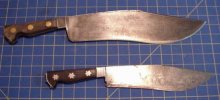Gorgeous barong pic, Fed. Barongs definitely have lines that I love. Very elegant.
The failure involved the pitch/laha. Basically, it separated inside the handle during a carenza (shadow boxing type drill) session. I had worked the barong through a quick series of movements with rapid directional changes (rendondo-snap-figure-8). There was a loud "click" on the last backstroke. I stopped immediately.
After some rotation and tugging, I was able to remove the blade and pitch from the handle as a unit. The thing was that the blade had passed the flex, wiggle and tug tests that I did with it each time before I used it.
As a side note, I had almost exactly the same thing happen with a partial tanged village khuk (the so-called "bulldog" model) yesterday while I was limbing a dead spruce. Only this time I was chopping and didn't hear the "click". The blade went flying. Luckily, I wasn't hurt. Again, it was a clean separation of the laha from the wood. I'll post a pic later.
S.
The failure involved the pitch/laha. Basically, it separated inside the handle during a carenza (shadow boxing type drill) session. I had worked the barong through a quick series of movements with rapid directional changes (rendondo-snap-figure-8). There was a loud "click" on the last backstroke. I stopped immediately.
After some rotation and tugging, I was able to remove the blade and pitch from the handle as a unit. The thing was that the blade had passed the flex, wiggle and tug tests that I did with it each time before I used it.
As a side note, I had almost exactly the same thing happen with a partial tanged village khuk (the so-called "bulldog" model) yesterday while I was limbing a dead spruce. Only this time I was chopping and didn't hear the "click". The blade went flying. Luckily, I wasn't hurt. Again, it was a clean separation of the laha from the wood. I'll post a pic later.
S.

